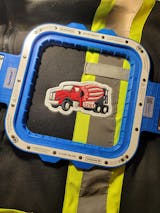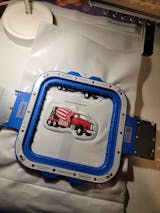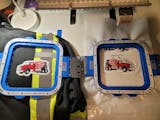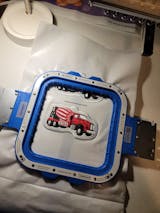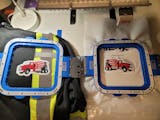1. Introduction: Mastering Singer Machine Threading Fundamentals
Threading a Singer sewing machine can feel like deciphering a secret code—one wrong turn, and your stitches go haywire. But once you master the fundamentals, you unlock smooth, frustration-free sewing and unleash your creative potential. This guide will walk you step-by-step through the essentials of using a sewing machine that embroiders: identifying core threading components, understanding model-specific quirks, troubleshooting common errors, and handling both the top thread and bobbin like a pro. Whether you're working with a classic Singer or a modern auto-threader, you'll learn how to set up your machine for flawless stitches every time. Ready to transform threading from a headache into a habit? Let’s dive in.
Table of Contents
- 1. Introduction: Mastering Singer Machine Threading Fundamentals
- 2. Core Threading Components Explained: Spool Pins to Needle Threaders
- 3. Step-by-Step Threading Walkthrough: Top Thread & Bobbin
- 4. Model-Specific Threading: Vintage to Modern Singer Machines
- 5. Thread & Needle Selection: Optimizing Stitch Quality
- 6. Troubleshooting Common Threading Errors
- 7. Conclusion: Key Takeaways for Perfect Singer Threading
- 8. FAQ: Singer Threading Essentials
2. Core Threading Components Explained: Spool Pins to Needle Threaders
Before you thread a single inch of cotton or polyester, it pays to know your machine’s anatomy. Each component—from the humble spool pin to the clever needle threader—plays a vital role in delivering perfect stitches. Let’s demystify these parts and reveal their secrets.
2.1 Spool Pins & Tension Discs: Setup for Smooth Thread Flow
The journey starts at the spool pin, the unsung hero perched atop your Singer. Depending on your model, you’ll find either a vertical or horizontal spool pin. Modern machines often feature telescoping horizontal pins for larger spools, while vintage Singers may sport upright pins. Always check your thread orientation: some threads unwind over the top, others from underneath—consult your manual or look for arrows and guides on your machine.
Next, secure the thread with the correct spool cap. Too tight, and the thread won’t feed; too loose, and you risk tangles (as highlighted in both YouTube tutorials and user forums). The right fit prevents snags and keeps your thread flowing smoothly.
Now, onto the tension discs—the gatekeepers of stitch quality. These hidden or visible discs regulate how tightly your thread is pulled. Always raise the presser foot before threading; this opens the tension discs, allowing the thread to slip between them without resistance. The tension dial (usually marked 0–9) adjusts how closely the discs press together. For most straight stitches, settings around 4–4.5 are standard, but always test on scrap fabric.
If you’ve ever battled thread breakage or uneven stitches, improper threading through the tension discs is often the culprit. “Floss” the thread back and forth as you guide it between the discs to ensure it seats properly—a tip echoed in both expert videos and sewing blogs.
2.2 Take-Up Levers & Needle Threaders: Routing Secrets Revealed
The take-up lever is your next checkpoint. This moving arm dances up and down as you sew, controlling thread feed and loop formation. To thread it correctly, turn the handwheel toward you until the lever reaches its highest point—this aligns the threading path and prevents skipped stitches.
Guide the thread through the lever’s eye from front to back, following the numbered slots or arrows on your machine. On older Singers, the lever is often more exposed and may require manual threading, while modern models tuck it behind sleek covers but still demand precision.
Enter the needle threader—a modern marvel for tired eyes and shaky hands. Many new Singer machines feature an automatic needle threader: lower the presser foot, bring the needle to its highest position, and engage the threader lever. Hook the thread around the tiny metal hook, release, and watch as the thread magically passes through the needle’s eye. If you’re using a vintage machine, you’ll be threading manually from front to back—steady hands and good lighting are your best friends.
Needle compatibility matters too. Use an 80/12 needle for medium-weight fabrics, 90/14 for heavier materials. Always match your thread and needle to your fabric for best results.
By understanding and respecting these components, you set the stage for frustration-free sewing and beautiful, balanced stitches.
3. Step-by-Step Threading Walkthrough: Top Thread & Bobbin
With the groundwork laid, let’s walk through the complete threading process—no skipped steps, no guesswork. Whether you’re using a basic Singer or a feature-rich model, these steps will get you sewing with confidence.
3.1 Top Thread Path: From Spool to Needle Eye
1. Prepare the Machine: Start with your machine powered off. Raise the presser foot—this opens the tension discs for effortless threading. Place your thread spool on the pin (vertical or horizontal, as your model dictates), and secure with the appropriate cap.
2. Follow the Guides: Thread through the initial guides near the spool pin, then down through the tension discs. For heavy threads, some models advise skipping the lowest guide to avoid over-tensioning—check your manual or on-machine diagrams.
3. Take-Up Lever: Turn the handwheel to bring the take-up lever to its highest position. Thread through the lever’s eye, then down through any remaining guides near the needle.
4. Thread the Needle: Guide the thread through the final guides above the needle, then insert it from front to back. Leave a 4–6 inch tail behind the needle.
Model-Specific Tips: Some Singers, like the 4423, offer app-based guidance or built-in diagrams. Always follow the numbered path on your machine for foolproof results.
3.2 Bobbin Winding & Insertion: Avoiding Uneven Spools
1. Wind the Bobbin: Place an empty, Singer-approved bobbin on the winder spindle. Thread through the bobbin winding tension disc for even, tight winding—a step emphasized in both video tutorials and expert guides. Wind the thread around the bobbin 5–6 times, then trim the excess.
Engage the bobbin winder (slide it right or press a lever), hold the thread tail, and start winding. When full, the machine will stop automatically on most models. Always use the correct bobbin type (e.g., Class 15 transparent for many modern Singers) to avoid jams.
2. Insert the Bobbin: Drop the wound bobbin into the case, ensuring the thread unwinds in the correct direction—usually counter-clockwise for most front-loaders, clockwise for some top-loaders. Pull the thread through the tension spring or slot until it clicks into place.
Troubleshooting: If your bobbin winds unevenly or feels “fluffy,” rethread through the pre-tensioner and try again. Always check that the bobbin spins freely in its case.
3.3 Securing Threads & Starting First Stitches
1. Raise the Bobbin Thread: Hold the top thread tail with your left hand. Turn the handwheel toward you, lowering and then raising the needle. A loop of bobbin thread will appear—pull it up through the needle plate.
2. Secure Both Threads: Pull both thread tails (top and bobbin) under the presser foot and toward the back of the machine. This prevents tangling and ensures clean, even stitches from the very first seam.
3. Test for Tension: Place a folded piece of scrap fabric under the presser foot. Lower the foot, sew a few stitches, and check both sides. If you see loops or bunching on the underside, rethread the top path—incorrect threading is the usual suspect. Test your machine embroidery design on scrap fabric
4. Prioritize Fabric Stability: Always test on two layers of fabric for best results. Properly securing your threads and stabilizing your fabric sets you up for sewing success.
Ready to put theory into practice? Thread your Singer with confidence, and let your creativity take center stage!
4. Model-Specific Threading: Vintage to Modern Singer Machines
Singer sewing machines are as diverse as the projects they help create. From the iron giants of industry to sleek, modern home models, each machine has its own threading quirks. Let’s break down the essential differences—so you can thread with confidence, no matter what’s under your needle.
4.1 Industrial Models (111W155) & Heavy-Duty (4423)
If you’ve ever stood before an industrial embroidery machines like Singer 111W155, you know it’s built like a tank—ready for leather, canvas, and high-volume work. Threading this industrial classic is a hands-on ritual, and getting it right means the difference between smooth stitching and a bird’s nest of thread.
Threading the 111W155: The U-Shape Ritual
- Start at the Top: Place your thread on the stand above the machine, ensuring the thread feeds smoothly downward. The angle matters—let gravity help.
- Tension Discs: Guide the thread through the top hole (right to left), then create a pronounced U-shape around the tension discs. This U-shape is crucial for proper tension—thread must pass between the discs, not just skim their surface.
- Hooks and Springs: Next, loop the thread through the various guides and springs, clicking it into place. These springs add a final layer of tension control—vital for heavy-duty threads.
- Take-Up Lever and Needle: Bring the thread up through the take-up lever (always at its highest point), then down through the remaining guides, and finally thread the needle from left to right.
Bobbin Setup: The 111W155 uses a top drop-in bobbin system. Drop the bobbin in, then manually pull the bobbin thread up using the handwheel. This tactile step is echoed in both expert videos and user forums—don’t rush it, and always check for smooth movement.
Pro Tip: When working with leather or other thick materials, tension is everything. If your thread keeps breaking, re-examine your path around the tension discs and check for burrs or snags. As one leatherworker put it, “Threading is half the battle—get it right, and the machine sings.”
Singer 4423: Heavy-Duty for Home
The 4423 brings industrial spirit to the home studio. Its threading process is streamlined, but attention to detail still pays off.
- Spool Placement: Use the vertical spool pin—no cap needed if upright. Make sure your thread unwinds smoothly.
- Follow the Guides: Thread through the numbered guides, down through the tension discs, under the guides, up through the take-up lever, and down to the needle.
- Bobbin: The 4423 features a top drop-in bobbin for easy access. Always use Singer-approved bobbins to avoid jams.
- Guided Setup: Take advantage of the SINGER Sewing Assistant App for visual step-by-step help, especially if you’re threading for the first time.
Leather-Specific Challenges: When sewing leather, use a sharp needle and strong polyester thread. If you notice skipped stitches or thread breakage, double-check the U-shape threading around the tension discs and consider lowering your speed for better control.
4.2 Auto-Threader Models (Stylist, 6700C) & Troubleshooting Tips
Modern Singer models like the Stylist and 6700C are designed to make threading almost effortless—if you know the right moves.
Auto-Threader Magic:
- Presser Foot Up: Always start with the presser foot raised to release the tension discs.
- Thread Path: Place your spool (vertical or horizontal, as your model requires), then follow the arrows or numbered guides: under the top hook, down, U-turn, through the tension discs, and up through the take-up lever.
- App Integration: Models like the 4423 and Stylist often feature app-based guides—use them for real-time, step-by-step visuals.
- Lever-Activated Threading:
- Bring the needle to its highest position using the handwheel.
- Pull down the auto-threader lever (usually on the left side).
- Hook the thread around the small hook, then under the metal hook within the threader.
- Slowly release the lever—the threader pulls a loop through the needle’s eye. Pull the loop to finish.
Troubleshooting Left-Side Hooks: If you’re baffled by the left-side hook (a common issue on the 6700C), remember: after the take-up lever, the thread must pass through the guide near the needle, then hook onto the left-side mechanism before using the auto-threader. YouTube demos show this step in detail—don’t skip it!
Key Differences: Vintage vs. Modern
| Model | Auto-Threader | Bobbin Type | Threading Path Highlights |
|---|---|---|---|
| 111W155 (Industrial) | No | Top Drop-In | Manual U-shape tension discs, left-to-right needle |
| 4423 (Heavy-Duty) | Limited/App | Top Drop-In | Numbered guides, take-up lever, app guidance |
| Stylist/6700C | Yes | Top Drop-In | Lever-activated threader, left-side hook, app help |
| Vintage Models | No | Front-Loading | Manual tension discs, hooks, left-to-right threading |
Bottom Line: Industrial models demand manual precision; modern home machines offer automation but require careful attention to guides and levers. Always consult your manual or app for model-specific quirks, and remember: threading is a dance—learn the steps, and you’ll sew with confidence.
5. Thread & Needle Selection: Optimizing Stitch Quality
The secret to flawless stitches isn’t just in the threading—it’s in the match between your thread, needle, and fabric. Let’s unravel the essentials for perfect results, every time.
5.1 Thread Types by Fabric: Cotton, Polyester, and Specialty Uses
Choosing the right thread is like picking the right partner for a dance—get it wrong, and you’ll stumble. Here’s how to make the perfect match:
| Thread Type | Ideal Fabric | Key Characteristics |
|---|---|---|
| Cotton | Linen, muslin | Natural fiber, minimal stretch, great for heirlooms |
| Polyester | Cotton, denim | Durable, flexible, all-purpose, handles stretch well |
| Silk/Nylon | Silk, knits | Smooth, strong, ideal for delicate or stretchy jobs |
Best Practices:
- Match Weight to Fabric: Use lighter threads (60–80 wt) for delicate fabrics, heavier threads (30–50 wt) for thick materials.
- Avoid Low-Quality Threads: Bargain-bin threads may fray, shed lint, or break—leading to skipped stitches and frustration. Invest in reputable brands for smoother sewing.
- Spool Fit: Ensure your thread spool fits snugly on the pin—loose spools can cause tension headaches.
Pro Tip: If you’re sewing stretch fabrics, polyester thread is your best friend—it flexes with the fabric, preventing breakage. For heirloom projects or crisp cottons, cotton thread delivers classic results.
5.2 Needle Compatibility: Sizes, Sharpness, and Replacement Cycles
A dull or mismatched needle is a recipe for disaster—think skipped stitches, fabric snags, or even machine damage. Here’s how to keep your needle game sharp:
| Needle Type | Fabric Application |
|---|---|
| Sharp | Woven fabrics (cotton, linen) |
| Ballpoint | Knits, stretch fabrics |
| Universal | General-purpose sewing |
Key Tips:
- Replace Often: Change your needle regularly—especially after sewing thick or abrasive fabrics. Dull needles cause skipped stitches and can damage fabric.
- Match Size to Thread: Thicker threads need larger needle eyes. If your needle struggles to pull the thread through, size up.
- Listen to Your Machine: If you hear thumping, skipping, or see uneven stitches, it’s time for a new needle.
Troubleshooting Table:
| Issue | Symptom | Solution |
|---|---|---|
| Skipped stitches | Gaps in seam, loose threads | Replace needle, check thread size |
| Puckering | Fabric gathers or wrinkles | Use lighter thread, adjust tension |
| Thread breakage | Sudden snap, fraying | Use quality thread, new needle |
Bottom Line: The right thread and needle combo is your ticket to professional-looking stitches. Don’t skimp—your machine (and your sanity) will thank you!
6. Troubleshooting Common Threading Errors
Even the best-threaded machine can throw a tantrum—broken threads, messy bobbins, or tension that just won’t behave. Let’s tackle the most common issues, so you can get back to stitching with a smile.
6.1 Thread Breakage & Tension Imbalances: Quick Fixes
Nothing stops a project faster than a snapped thread. Here’s how to diagnose and fix the most common culprits:
- Improper Threading Path: Double-check that your thread follows every guide—especially the take-up lever and tension discs. Missed a step? Rethread from scratch.
- Tension Settings: For cotton thread, start with your tension dial between 3–5. Test on scrap fabric and adjust as needed. If the upper thread breaks, gradually tighten the dial. For bobbin thread issues, adjust the tiny screw on the bobbin case.
- Dull or Bent Needles: Replace needles often, especially after sewing thick or tough fabrics. A fresh needle glides through fabric, reducing friction and breakage.
Visual Clues:
- Loose Upper Thread: Loops on the underside—tighten upper tension.
- Tight Upper Thread: Puckered fabric—loosen upper tension.
- Loose Bobbin Thread: Bobbin thread visible on top—tighten bobbin case screw.
- Tight Bobbin Thread: Upper thread visible underneath—loosen bobbin case screw.
Pro Tip: Always thread with the presser foot up—this opens the tension discs for smooth threading.
6.2 Bobbin Issues: Winding Irregularities and Insertion Failures
A poorly wound or incorrectly inserted bobbin can sabotage your stitches. Here’s how to keep things running smoothly:
- Uneven Winding:
- Slow down! Wind bobbins at a moderate speed for even tension.
- Use only Singer-compatible bobbins—mixing sizes disrupts alignment.
- Thread must pass through the bobbin winder tension disc. If your bobbin looks fluffy or uneven, rewind it.
- Insertion Errors:
- For top drop-in bobbins, ensure the thread unwinds in the correct direction—usually counter-clockwise.
- Pull the thread through the tension spring or slot until it clicks.
- If you hear rattling or see tangles, reinsert the bobbin and check for proper placement.
| Issue | Symptom | Solution |
|---|---|---|
| Uneven winding | Fluffy or loose bobbin | Rewind at moderate speed, check tension |
| Insertion failure | Bobbin rattles, thread jams | Reseat bobbin, verify orientation |
| Thread bunching | Loops under fabric | Rethread top and bobbin, check guides |
6.3 Fabric Stability Solutions for Flawless Stitches
Ever tried embroidering thick denim or a plush towel, only to battle shifting fabric and uneven tension? The secret weapon: magnetic embroidery hoops.
Why Magnetic Hoops (Like Sewtalent) Make a Difference:
- Even Tension, Every Time: Magnetic hoops automatically adapt to fabric thickness, holding everything from delicate cotton to multi-layered towels securely—no manual screw adjustments needed.
- No More Slippage: Unlike traditional screw hoops that can loosen or slip (especially on heavy fabrics), magnetic hoops keep your material rock-steady throughout the stitching process.
- Prevents Hoop Burn: The even pressure of magnets reduces visible marks on finished garments, preserving your hard work.
Sewtalent: The Pro’s Choice
Sewtalent’s magnetic embroidery hoops are engineered for garment embroidery, offering a powerful magnetic clamping system, ultra-durable materials, and compatibility with hundreds of machine models. They’re especially effective for thick or tricky fabrics where traditional hoops fall short. Plus, the quick setup saves serious time—just snap in your fabric and go.
| Feature | Magnetic Hoop (Sewtalent) | Screw Hoop |
|---|---|---|
| Setup Time | Seconds | Minutes |
| Fabric Range | Thin silk to thick towels | Limited, struggles with thick |
| Tension Consistency | Even, automatic | Manual, prone to slippage |
| Fabric Protection | Minimal marks | Risk of hoop burn |
Bottom Line: If you’re tired of fighting fabric movement or re-hooping thick materials, it’s time to upgrade your toolkit. Magnetic hoops like Sewtalent transform tricky projects into smooth, frustration-free embroidery—so you can focus on your creativity, not your setup.
If issues persist, consult embroidery machine repairs near me.
Ready to troubleshoot like a pro? With these fixes and tools, you’ll spend less time untangling threads and more time bringing your designs to life.
7. Conclusion: Key Takeaways for Perfect Singer Threading
Threading a Singer sewing machine may seem daunting at first, but with a little practice and a clear understanding of each component, you’ll soon move from confusion to confidence. Remember to identify and respect every part—spool pin, tension discs, take-up lever, and needle threader—since each plays a vital role in achieving flawless stitches. Always follow the model-specific threading path, keep your tension balanced, and never underestimate the importance of securing both thread tails before you sew.
For garment embroidery projects, upgrade to the best embroidery machine toolkit can make all the difference. That’s where Sewtalent’s magnetic embroidery hoops come in: their powerful magnetic system ensures even tension, minimizes rethreading, and keeps your fabric perfectly in place—especially on tricky materials. With the right technique and the right tools, you’ll spend less time troubleshooting and more time bringing your creative visions to life.
8. FAQ: Singer Threading Essentials
8.1 Q: Why does my thread keep breaking?
A: Thread breakage is most often caused by a dull or bent needle, incorrect tension settings, or improper threading. Start by replacing your needle, double-check your threading path, and adjust your tension dial within the recommended range for your thread and fabric.
8.2 Q: How often should I clean tension discs?
A: For best results, clean your tension discs weekly—especially if you sew frequently or use lint-prone threads. A small brush or a piece of unwaxed dental floss can help remove built-up lint and debris.
8.3 Q: Can I use generic bobbins in my Singer machine?
A: It’s best to use Singer-approved bobbins that match your specific model. Generic or incorrect bobbins can cause uneven stitches, thread jams, or even damage your machine.
8.4 Q: What’s the correct direction for bobbin insertion?
A: Most Singer machines require the bobbin thread to unwind counter-clockwise for front-loading bobbins and clockwise for some top-loading models. Always check your manual or look for directional diagrams on your machine.
8.5 Q: How do I know if my machine is threaded correctly?
A: After threading, test on a scrap of fabric. If both sides of the stitch look clean and even, you’re good to go. Loops or messy stitches on the underside usually mean the upper thread isn’t threaded properly—rethread and try again.
8.6 Q: Is it okay to turn the handwheel backward?
A: Always turn the handwheel toward you (counterclockwise). Turning it backward can cause jams or throw off your machine’s timing.
With these answers and a step-by-step approach, you’re ready to tackle Singer threading like a pro. Happy sewing!



